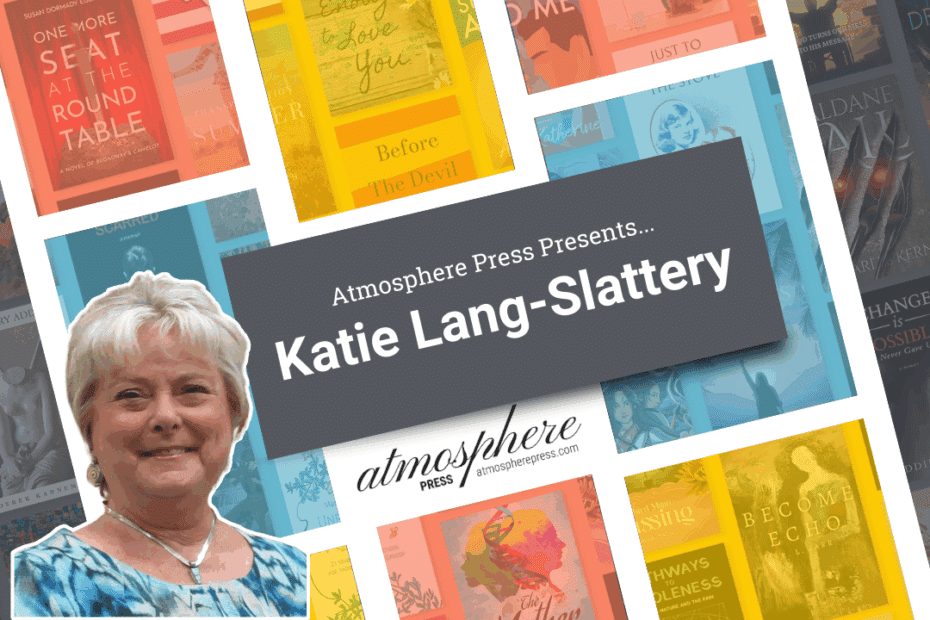An Interview with Katie Lang-Slattery

Katie Lang-Slattery began her writing career in the youth periodical market. She published her first adult book in 2015, at the age of 72. This historical novel, Immigrant Soldier, The Story of a Ritchie Boy, has garnered awards and fans. Her children’s chapter book series, Tagalong Caitlin, Caitlin’s Buddy, and Caitlin’s Party, is about the camp experiences of a little girl with big ideas and determination. Katie’s memoir, Wherever the Road Leads, recounts two years living in a VW van in the 1970s, driving across four continents. She is currently completing her second novel, Ashes and Ruins, a mother/daughter story that takes place in Nazi Germany and Blitz-torn London. Katie lives in Laguna Beach, California, only steps from her childhood home. Besides writing, her main interests are cooking and painting, and she continues to travel the world, especially to her favorite destinations in Asia and Europe.
Who/what made you want to write? Was there a particular person, or particular writers/works/art forms that influenced you?
Since childhood, I have loved books and reading. I always had a book under my bed ready to read as soon as I woke up. Later, in high school, I found I had an aptitude for writing essays and more creative pieces. However, in college, I studied art, my other passion, though I never entirely gave up writing, and certainly never stopped reading. Many writers have inspired me, notably Ernest Hemingway, Pearl S. Buck, and Isabelle Allende, but it was mainly my love affair with books that led me to become an author.
What inspired you to start writing this book?
My first novel, Immigrant Soldier, is based on my uncle’s experiences as a refugee from Nazi Germany, a U.S army officer trained to interrogate prisoners of war, and a confidant of General Patton. After the book was published, I kept thinking about the women who had been part of that story. The struggles of my aunt and grandmother during the early years of the Nazi regime and later under the bombs of the London Blitz, fascinated me. I felt the quiet heroism of women was as important as the tales of men in the military and I wanted to write their story too.
Tell us the story of your book’s title. Was it easy to find, or did it take forever?
When I first started writing the story of my grandmother and my aunt, I used the working title, Love in the Ruins. As the first draft developed, I realized the story was divided into two main segments: the time in Nazi Germany between 1933 and 1939 and the years in London from 1939 to 1943. I titled the first section Ashes, and the later section Ruins. These division titles gradually took hold in my understanding of the story and the symbols I used, until I knew that together they made a better book title. Now the title is Ashes and Ruins. Currently I am struggling to decide if a subtitle is needed and, if so, what it will be. Some of my ideas are: A Story of Love and War; Love, Family, and the Home Front; and A Story of Family, from Nazi Germany to the London Blitz.
If your book had a soundtrack, what are some songs that would be on it?
The love of music plays an important part in the life of the main character of Ashes and Ruins. Clara plays the piano and violin and loves classical music. Some of the pieces mentioned in the manuscript are “Hungarian Dances” by Brahms, “Clair de Lune” by Debussy, the music of Liszt, Chopin, and Bach, and, most importantly, Mozart’s “Requiem Mass.”
Clara’s daughter, Edith, is a party girl who loves to dance, so the popular music of the 1930s and 40s should also be a part of any soundtrack for my book, especially for the London chapters.
What other professions have you worked in? What’s something about you that your readers wouldn’t know?
Back in the late 1960s, I taught English and Art in a public junior high school. Since then, I’ve taught adult cooking, been a substitute teacher, sold used toys at swap meets, been a mother, and for 27 years was a Girl Scout leader. For two years in the 1970s, I lived in a Volkswagen van traveling the world, an adventure you can read about in my memoir, Wherever the Road Leads. I still love to travel, have visited every continent except Antarctica, and last year I went to India for the third time!
What books did you read (for research or comfort) throughout your writing process?
Too many to list! Multiple dozens at a minimum – everything from academic books to primary sources, from non-fiction about WWII to contemporary publications from the war years. While researching for the British home front chapters, I sought out publications produced at the time to help homemakers manage shortages. Make Do and Mend, first published by the Ministry of Information in 1943, was pure nostalgia. The Home Front, Pocket Manual 1939 -1945, a compilation of information from a variety of contemporary newspapers and women’s magazines, was fun to read and a terrific resource, too. In a lighter vein, I read several women’s romantic novels first published in the late 1930s and early 1940s. These romances were both relaxing and enlightening.
What advice would you give your past self at the start of your writing journey?
“Don’t put it off. Just set a goal and start. When life gets in the way, starting is the most difficult part.”
My life was so busy (and satisfying) that I put off serious efforts to be a writer until after I turned fifty. If I had started earlier, I might have been able to produce much more.
What’s one thing you hope sticks with readers after they finish your book?
Two things, really.
In Germany, the Nazi laws were incremental. It wasn’t easy for Jews to know if or when they should leave. The answers to this dilemma, as well as the small resistances, were always individual.
The quiet heroism of women during times of stress and upheaval may not be dramatic or filled with life-threatening action, but it is the glue that holds families, and thus civilizations, together.
Are you a writer, too? Submit your manuscript to Atmosphere Press.

Atmosphere Press is a selective hybrid publisher founded in 2015 on the principles of Honesty, Transparency, Professionalism, Kindness, and Making Your Book Awesome. Our books have won dozens of awards and sold tens of thousands of copies. If you’re interested in learning more, or seeking publication for your own work, please explore the links below.
